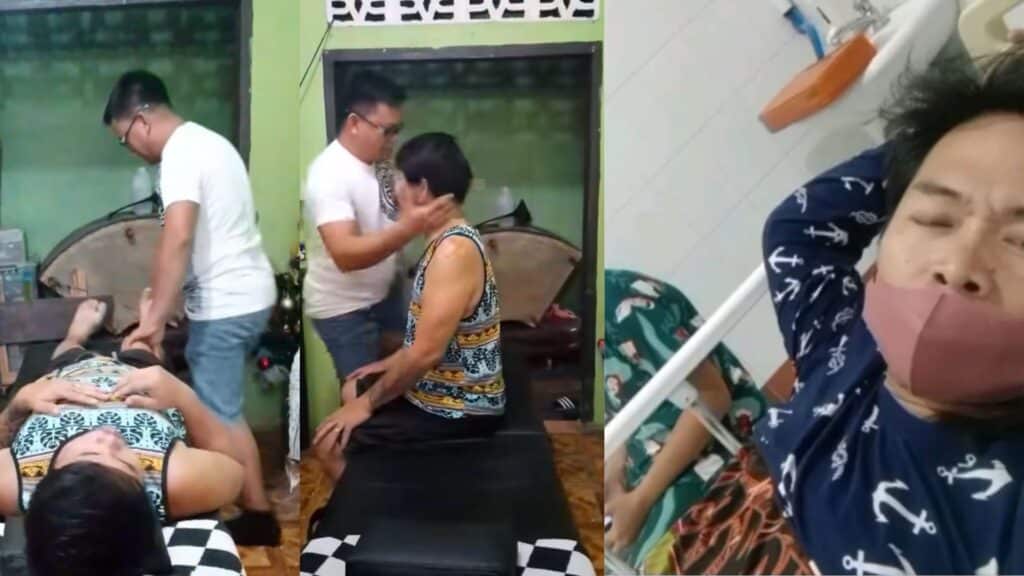
A man from Cagayan de Oro suffered a fractured leg after seeking treatment from an unlicensed chiropractor. | Leobert Mangubat Yurong/Facebook Reel
CEBU CITY, Philippines — The untimely death of Thai singer Phing Chyada following a massage involving a neck-twisting technique has troubled the public about the risks of unlicensed manual therapies.
She was seeking relief from shoulder pain, but Chyada instead experienced a tragic turn of events that left her paralyzed and, later, dead. She was 20.
In the Philippines, unregulated massage and chiropractic practices have also led to devastating outcomes. In Cagayan de Oro, Leobert Mangubat Yurong sustained a fractured leg after undergoing a chiropractic session with an untrained practitioner.
What began as a routine visit for relief escalated into a costly ordeal, with Yurong’s medical bills amounting to over P170,000.
In an exclusive interview with CDN Digital, licensed physical therapist and Philippine Physical Therapy Association (PPTA) President Michael Pereyra Gabilo delves into the risks, misconceptions, and need for regulations in the burgeoning field of manual therapies in the country.
The problem of unlicensed practitioners
According to Gabilo, the Philippines needs proper regulation for chiropractic practices. The lack of regulation, he said, creates a gray area where untrained individuals operate unchecked.
“There is no institution in the Philippines that offers a chiropractic medicine program. Chiropractors practicing here often have degrees from abroad, but without local regulation, even those trained cannot be overseen by the Professional Regulation Commission (PRC),” Gabilo explained.
This absence of governance has opened the floodgates for individuals, often known as “bone settlers,” to advertise chiropractic services without proper credentials. He said that these practitioners pose a threat due to their lack of medical knowledge and accountability.
“When someone without training handles delicate areas like the neck or spine, they don’t just risk failing to provide relief, they risk permanent injury, paralysis, or even death,” he said.
The anatomy of risk
The human neck is an intricate structure, housing critical neurological pathways connecting the brain to the spinal cord. Gabilo explained that improper manipulations, such as the neck-twisting technique that led to Chyada’s paralysis, can cause irreparable damage.
“Rotational forces applied to the neck can stretch or tear vital tissues. Worse, they can disrupt the spinal cord’s functionality, affecting breathing, heart rate, or motor functions. In severe cases, the damage can cascade to a point where the body can no longer recover,” he warned.
In Yurong’s case, the untrained practitioner applied excessive force that fractured his leg during what was supposed to be a simple adjustment. This mishandling not only caused physical pain but also led to financial burdens, with medical expenses reaching over P173,000.
Why do Filipinos seek unlicensed therapists
Gabilo explained that the prevalence of unlicensed practitioners is due to multiple factors, including accessibility, economic limitations, and a lack of awareness.
He said that many Filipinos in rural areas have limited access to licensed physical therapists which is often filled by unqualified individuals who exploit the community’s lack of options.
He added that economic constraints push many to seek unlicensed practitioners, considering them more affordable than professional care. However, this short-term cost-saving measure often results in long-term consequences.
“Many Filipinos mistakenly believe that bone settlers or massage therapists trained informally possess sufficient knowledge. What they don’t see are the risks of entrusting their health to someone without proper medical education,” Gabilo said.
When massage or manipulation becomes dangerous
While massage and chiropractic therapies are often sought for pain relief, certain medical conditions can make such interventions dangerous. Gabilo explained the risks for patients with malignancies, such as sarcoma or other cancers.
“Massage increases blood circulation, which could accelerate the spread of cancer cells,” he explained.
Additionally, patients with osteoporosis, herniated discs, or underlying neurological conditions are at heightened risk of injury from improper handling. Unlicensed practitioners are often unaware of these contraindications, which could lead to treatments that worsen the patient’s condition.
Safer alternatives for pain relief
For individuals experiencing minor discomfort or stiffness, Gabilo recommended simple and safe remedies that can be done at home.
Hot compresses, for example, help relax muscles and improve blood circulation. Gentle stretches can also relieve tension without the risks associated with manual manipulation.
However, he warned that persistent or radiating pain, particularly when it extends to the arms or legs, should not be ignored.
“Pain that radiates is often a sign of a more serious issue involving the nerves or spine. In such cases, seeing a licensed professional is critical. Attempting to self-treat or consulting unlicensed individuals can lead to irreversible damage,” he advised.
How to identify a licensed professional
To ensure safety, Gabilo urged the public to verify the credentials of healthcare providers. Licensed physical therapists in the Philippines are registered with the PRC, and their licenses should be displayed prominently in clinics.
Patients can also verify a practitioner’s legitimacy through the PRC’s online database.
“Don’t hesitate to ask for proof of credentials…Your health and safety are on the line. A true professional will understand the importance of transparency and accountability,” he said.
The need for regulation
With this, Gabilo cited the need to establish a regulatory framework for chiropractic practices in the Philippines. Without proper oversight, both practitioners and patients remain vulnerable to the consequences of unregulated care.
“Regulation is not just about policing unlicensed individuals; it’s about setting standards to ensure safe and effective practices. Chiropractors who are properly trained deserve recognition, and patients deserve protection,” he explained. /clorenciana